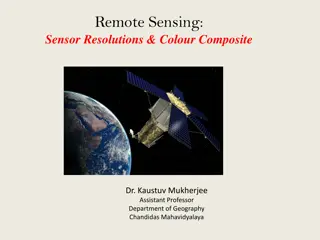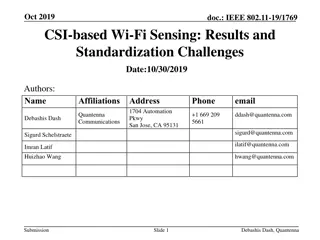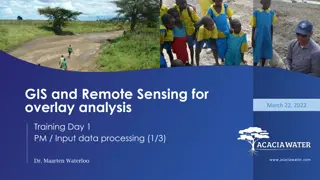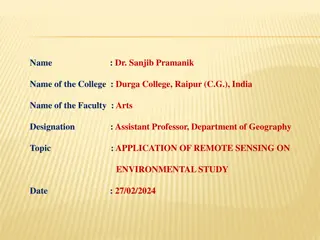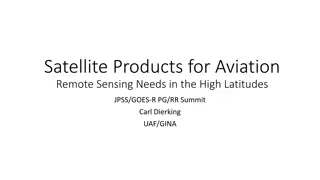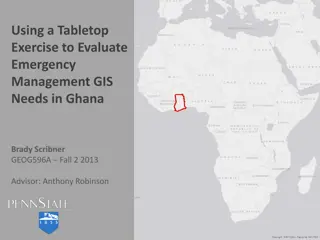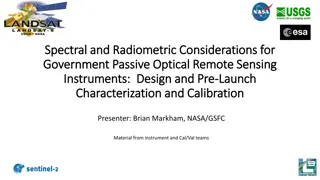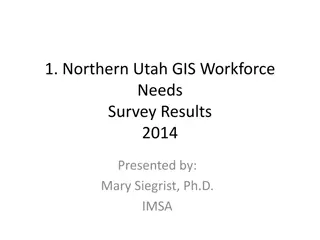Remote Sensing and GIS Applications in Photogrammetry: Understanding Scale Variations
Exploring the fundamental principles of photogrammetry in remote sensing and GIS applications, this content delves into the science of measurements from aerial photographs. It discusses the implications of scale differences on maps and aerial photographs, emphasizing the variations in scale due to terrain elevation. Additionally, it explains how the scale of vertical photographs changes over flat and variable terrains, providing a comprehensive overview of the concept.
Download Presentation

Please find below an Image/Link to download the presentation.
The content on the website is provided AS IS for your information and personal use only. It may not be sold, licensed, or shared on other websites without obtaining consent from the author.If you encounter any issues during the download, it is possible that the publisher has removed the file from their server.
You are allowed to download the files provided on this website for personal or commercial use, subject to the condition that they are used lawfully. All files are the property of their respective owners.
The content on the website is provided AS IS for your information and personal use only. It may not be sold, licensed, or shared on other websites without obtaining consent from the author.
E N D
Presentation Transcript
Remote Sensing and GIS Application Lecturer Ruba Yousif Hussain Third Year 1
Remote Sensing and GIS Application Lecturer Third Year Ruba Yousif Hussain Basic Principal of Photogrammetry Photogrammetry Photogrammetry is the science of making measurements from aerial photographs. Vertical photographs Photographs taken from an aircraft with the optical axis of the camera vertical or as nearly vertical as possible . Scale On a map, scale is everywhere uniform because a map is an orthographic projection. An aerial photograph, is a perspective projection and its scale varies with variations in terrain elevation. 2
Remote Sensing and GIS Application Lecturer Third Year Ruba Yousif Hussain Figure 1 Geometry of a vertical photograph 3
Remote Sensing and GIS Application Lecturer Third Year Ruba Yousif Hussain (a)Map (orthographic projection) Constant scale No relief displacement (b)Photo (perspective projection) Varied scale Relief displacement Figure 2 4
Remote Sensing and GIS Application Lecturer Third Year Ruba Yousif Hussain Scale of a Vertical Photograph over Flat Terrain The ratio of the photo distance ab to the corresponding ground distance AB. That scale may be expressed in terms of camera focal length f and flying height above ground H' . ab f = = S AB H S = S = Figure 3 Two dimensional view of a vertical photograph taken over flat terrain. Example 1 A vertical aerial photograph is taken over flat terrain with a 6 in (152.4 mm ) focal length camera from an altitude of 6000 ft above ground. What is the photo scale ? Solution 6000 ft H 6 1 1 f in in = = = = S 1000 12000 ft 5
Remote Sensing and GIS Application Lecturer Third Year Ruba Yousif Hussain Scale of a Vertical photograph over Variable Terrain The scale at any point whose elevation above datum is h may be expressed as S = f H h For vertical photographs taken over variable terrain, there are an infinite number of different Scales. This is one of the principal differences between a photograph and a map . Average Photo Scale f = ( ) S average ( ) H h average 6
Remote Sensing and GIS Application Lecturer Third Year Ruba Yousif Hussain Figure 4 Scale of a vertical photograph over variable terrain. 7
Remote Sensing and GIS Application Lecturer Third Year Ruba Yousif Hussain Example 2 Suppose that highest terrain h1,average terrain haverage, , and lowest terrain h2 , of Figure 4 are 2,000, 1,500, and 1,000 ft above mean sea level, respectively. Calculate maximum scale, minimum scale, and average scale if flying height above mean sea level is 10,000 ft and camera focal length is 6 in (152.4 mm). Solution Maximum scale occurs at maximum elevation 6 max = ft h H 6 1 1 f in in in = = = = S 10000 ( 2000 ) 8000 1333 16000 ft ft 1 Minimum scale occurs at minimum elevation f S 6 6 1 in in in = = = = : 1 = 18000 min 10000 ( 1000 ) 9000 1500 H h ft ft ft 2 Average Scale 6 6 1 1 f in in in = = = = = : 1 = 17000 S average 10000 ( 1500 ) 8500 1417 17000 H h ft ft ft average 8
Remote Sensing and GIS Application Lecturer Third Year Ruba Yousif Hussain Example 3 A camera equipped with a 152 mm focal-length lens is used to take a vertical photograph from a flying height of 2780 m above mean sea level. If the terrain is flat and located at an elevation of 500 m, what is the scale of the photograph? Solution 1 ) 500 2780 ( m h H 152 mm f = = = S 15000 Example 4 Assume a vertical photograph was taken at a flying height of 5000 m above sea level using a camera with a 152 mm focal length lens, (a) Determine the photo scale at points A and B, which lie at elevations of 1200 and 1960 m. (b) What ground distance corresponds to a 20.1 mm photo distance measured at each of these elevations? Solution a- 1 ) 1200 5000 ( ft A h H . 0 152 . 0 152 1 f m f m = = = = = = , SB SA 5000 ( 1960 ) 20000 25000 H h ft B b- photo distance 1 0.0201m = = = S ground distance 25000 ground distance 1 1 0201 . 0 = = 0201 . 0 = = , ground distance at B 402 m ground distance at A 502 5 . m 20000 25000 9
Remote Sensing and GIS Application Lecturer Third Year Ruba Yousif Hussain Example 5 The horizontal distance AB between the centers of two street intersections was measured on the ground as 1320 ft. The corresponding line ab appears on a vertical photograph and measures 3.77 in. What is the scale of the photo at the average ground elevation of this line? Solution . 3 77 1 1 ab in in = = = = : 1 = 4200 S 1320 350 4200 AB ft ft Photographic scale can then be calculated from the following equation: photo distance = map scale S distance map Example 6 Ona vertical photograph the length of an airport runway measures 6.30 in. On a map which is plotted to a scale of 1:24,000, the runway scales 4.06 in. What is the scale of the photograph at runway elevation? Solution 6.30in 1 1 = = = = 1 1290 S in ft 4.06in 24000 15470 10
Remote Sensing and GIS Application Lecturer Third Year Ruba Yousif Hussain Example 7 Assume that two road intersections shown on a photograph can be located on a 1 : 25000 scale topographic map. The measured distance between the intersections is 47.2 mm on the map and 94.3 mm on the photograph, (a) What is the scale of the photograph? (b) At that scale, what is the length of a fence line that measures 42.9 mm on the photograph? Solution a- 1 47.2 distance map photo distance 94.3 1 1 = = = = map scale S 25000 12513 25557 . 12500 b- photo distance = S ground distance 1 42.9 = 12500 ground distance = = = ground distance 12500 9 . 2 4 536250 536 25 . mm m 11
Remote Sensing and GIS Application Lecturer Third Year Ruba Yousif Hussain Ground Coordinates from a Vertical Photograph Figure 5 shows a vertical photograph taken at a flying height H above datum. Images a and b of the ground points A and B appear on the photograph, and their measured photographic coordinates are xa , ya , xb , and yb . The ground coordinates of points A and B are XA , YA , XB , and YB . H h H h A A = = ( ) Y y ( ) X x a a A A f f H h H h B B = = ( ) ( ) Y y X x B B b b f f The horizontal length of the line AB can be calculated 2 2 = + ( ) ( ) AB X X Y Y B A B A The horizontal angle APB may be calculated as Y X 1 1 90 B A + + tan tan = APB Y X B A 12
Remote Sensing and GIS Application Lecturer Third Year Ruba Yousif Hussain Figure 5 Ground coordinates from a vertical photograph 13
Remote Sensing and GIS Application Lecturer Third Year Ruba Yousif Hussain Example 8 A vertical aerial photograph was taken with a 6-in (152.4 mm ) focal-length camera from a flying height of 4530 ft above datum. Images a and b of two ground points A and B appear on the photograph, and their measured photocoordinates (corrected for shrinkage and distortions ) are xa= -52.35 mm , ya = - 48.27 mm , xb = 40.64 mm , and yb = 43.88 mm. Determine the horizontal length of line AB if the elevations of points A and B are 670 and 485 ft above datum, respectively. Solution 35 . 52 = = ( 4530 670 ) 1326 ft X A 152 4 . 2 2 = + + + 1079 ( 1326 ) 1165 ( 1223 ) AB 48 27 . = 1223 ( 4530 670 ) ft = Y A 152 40 = 4 . 64 . 2 2 = + = ( 2405 ) ( 2388 ) 3389 AB ft = ( 4530 485 ) 1079 ft X B 152 4 . 43 88 . = ( 4530 485 ) 1165 ft = Y B 152 4 . 14
Remote Sensing and GIS Application Lecturer Third Year Ruba Yousif Hussain Endlap and Sidelap The overlap provides coverage of the entire ground area from two viewpoints, such coverage being necessary for stereoscopic viewing and measuring. Figure 6 End lap of photographs in a flight strip. Figure 7 Side lap of adjacent flight strips. 15
Remote Sensing and GIS Application Lecturer Third Year Ruba Yousif Hussain End lap Side lap 1. Common area covered by two successive photos of the same flight line or strip 1. Common area covered by two adjacent flight lines / strips 2. Usually 60 % 5 % 2. About 25-30 % 10 % (generally 30 % ) The ground distance between the photo centers at the times of exposure is called the air base. The ratio between the air base and the flying height above ground determines the vertical exaggerationperceived by photo interpreters. The larger the base-height ratio, the greater the vertical exaggeration. Uses of Photogrammetry 1. topographic mapping 2. highway planning and design 3. geologic maps 4. traffic management 5. military intelligence 16
Remote Sensing and GIS Application Lecturer Third Year Ruba Yousif Hussain Area Measurement 1 = hoto Ground area p area 2 S Example 9 A rectangular agricultural field measures 8.65 cm long and 5.13 cm wide on a vertical photograph having a scale of 1:20000. Find the area of the field at ground level. Solution distance photo = S ground 20000 = = 1 0.0865 = , ground distance distance ground length 0865 . 0 20000 1730 m = = ground width 0513 . 0 20000 1026 m Ground area = 1730 m 1026 m = 1774980 m2 Example 10 The area of a lake is 52.2 cm2 on a 1:7500 vertical photograph. Find the ground area of the lake. Solution 1 area p area Ground hoto = = 2 2 = 00522 . 0 7500 293625 m 2 S 17
Remote Sensing and GIS Application Lecturer Third Year Ruba Yousif Hussain Relief Displacement Figure 8 Geometric components of relief displacement 18
Remote Sensing and GIS Application Lecturer Third Year Ruba Yousif Hussain D= R h H Expressing distances D and R at the scale of the photograph, we obtain r h d= H Rearranging the above equation yields rh d = H where d = relief displacement r = radial distance on the photograph from the principal point to the displaced image point h = height above datum of the object point H = flying height above the same datum chosen to reference h Example 11 For the photo shown in Figure 8 , assume that the relief displacement for the tower at A is 2.01 mm , and the radial distance from the center of the photo to the top of the tower is 56.43 mm . If the flying height is 1220 m above the base of the tower, find the height of the tower. Solution m mm r 43 . 56 . 2 01 1220 dH = = = 43 45 . h m mm 19



